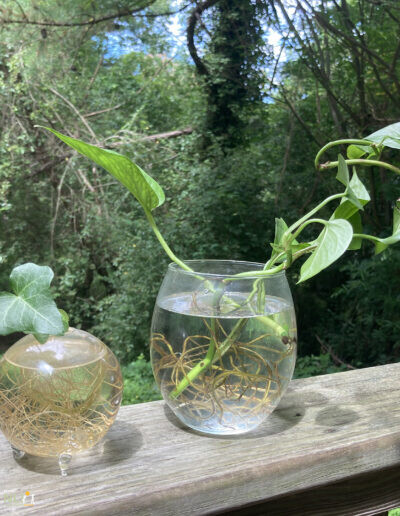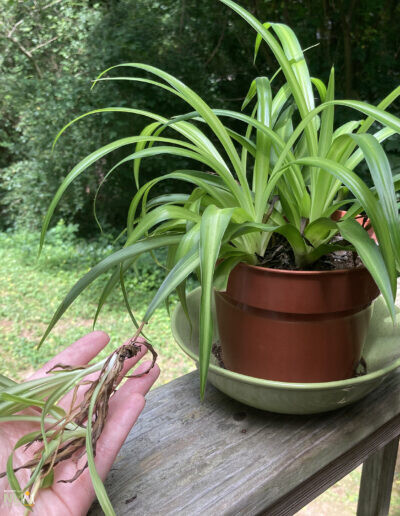20. Indoor Plants for Homes and Classrooms
Indoor plants provide numerous benefits to both classroom and home environments, including a reduction in stress levels, improved concentration, and improved air quality. Children enjoy the opportunity to care for plants through watering, pruning, and propagation: pieces of classroom plants can be rooted and sent home with students to engage families. This InfoSheet outlines low maintenance indoor plants, light and water requirements, and known levels of toxicity.
LIGHT CONDITIONS
Indoor plants thrive in a variety of lighting conditions depending on their species. Some plants can tolerate a wide variety of lighting conditions, while others have very specific requirements. It it crucial to understand the lighting that a home or classroom has available and choose plants accordingly. Keep in mind that lighting will change with weather and the seasons.
Direct sunlight. If the sun’s rays directly hit a plant through a window, that is considered direct sunlight. This is most common in south-facing windows.
Indirect light. Indirect light occurs when the sun’s rays are reflected off of something else before hitting the plant. Plants often receive bright, indirect light by being close to windows — place a sheer curtain on windows that receive direct sunlight to prevent plants from getting their leaves burned.
Low light. Low-light conditions indicate that no direct light will touch the plant. Low-light plants can be placed a few feet away from a light source or in a room with artificial light. Low-light doesn’t mean “no light,” but if a window is unavailable, ambient artificial lights such incandescent bulbs, fluorescent lights, or LED lights will suffice.
WATERING REQUIREMENTS
Well-draining, high-quality potting soil and proper drainage are crucial for correctly watering indoor plants. Containers for indoor plants should have holes on the bottom to allow water to drain: place a small dish, plate, or shallow container under containers to avoid leaks. Check specific water needs for each plant and keep in mind that over-watering is the most common cause of death for indoor plants. Do not water on a regular schedule: instead, stick your finger in the soil to check if it’s moist or dry. Water the soil rather than the plant to avoid mold and rot.
Toxicity level
Some common, low-maintenance indoor plants can be toxic if extensively handled or consumed, though symptoms are often mild. Children getting sick by consuming indoor plants is extremely rare, and more commonly occurs in pets. The benefits of connecting children to plants and nature while indoors far outweighs the risks. However, be mindful of where plants are located indoors and the age of children in areas with indoor plants: even mildly toxic plants should never be brought into an infant/toddler area. If a child consumes any part of an indoor plant, call poison control immediately.
For full list of plants see PDF
PROPAGATING PLANTS
Propagation is a free and educational method of sharing and multiplying plants. Below is an overview of the most common propagation methods for houseplants. For further information on plant propagation, refer to the Resources section of this InfoSheet.
Division. Division is a propagation method for multi-stemmed plants that produce stems at their base. Division also works for plants that have “offsets,” such as spider plants. To divide a plant, remove it from the container and separate it into smaller segments with a knife or your fingers. Ensure that each division has roots and re-pot the parent plant.
Rooting stem cuttings. Stem cuttings are a simple method of propagating vining plants, such as pothos. Identify the plant’s nodes along the stem (small bump that produces roots). Make a diagonal cut between two nodes, creating a cutting between 3–5 inches long. Place the cutting in either soil or water to root. If placed in soil, keep consistently moist.
Rooting leaves. Some plants can be propagated by rooting leaves. Snake plants, which have thick, fleshly leaves, can be multiplied by cutting the long leaves into smaller pieces and placing them directly in soil. Leaves with petioles (leaf stalks) can also be propagated for certain plants, including African violets. Place the leaf and leaf stalk directly in rooting medium (soil or water).
Resources
- Home Propagation of Houseplants, University of Missouri, MU Extension (2012).
- Propagating Houseplants, NC Cooperative Extension (2020). https://wayne.ces.ncsu.edu/2019/08/propagating-houseplants/



